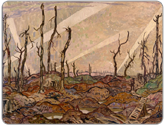The transformative power of war
March 10, 2014
War changes people and their perceptions of the world. That much is clear in Transformations – A.Y. Jackson and Otto Dix, a groundbreaking exhibition exploring the evolution of two very different artists who both served during the First World War. A. Y. Jackson, a founding member of the Group of Seven, is fondly remembered as a painter of iconic Canadian landscapes. German expressionist Dix, in contrast, was for years labelled “degenerate” because of his unflinching depictions of human injury, destruction and death.
The exhibition features more than 70 landscape paintings, drawings and prints arranged chronologically into five sections that cover the artists’ early years, each world war, the interwar period and the artists’ later years.
“Viewing the works of A. Y. Jackson and Otto Dix side by side is a powerful experience,” says James Whitham, Director General of the Canadian War Museum. “It’s fascinating to see how each funnelled his experience on the front lines into landscapes that are not necessarily associated with war. The deeper meaning and relationship to national identity fully emerges when seen within a larger cultural and social context.”
Both artists depicted the ravages of war: Jackson in trees stripped bare and craters gouged by exploding shells, and Dix in trenches filled with the remains of dead soldiers. Dix confronted the horror head-on, while Jackson’s approach was more calculated.
Following the First World War, Jackson resituated his lifeless trees in the rugged Canadian wilderness, where natural regeneration served as a metaphor for Canada’s renewal and the emergence of a strong national identity. Dix’s works were more subtle. He reconfigured his death-filled trench scenes into seemingly pastoral landscapes threatened by decaying vegetation, as a means of symbolizing Germany’s weakened state under National Socialism.
Throughout the Second World War and after, Dix, reviled by the Nazi regime for his subversive works, continued to express a deep sense of pessimism for Germany through these dark and mournful landscapes, which remain little-known. He eventually regained his reputation as an important artist for his earlier figurative work. Jackson’s reputation has remained steady due to his association with Canada’s celebrated Group of Seven and the popularity of his Canadian landscapes.
Transformations – A.Y. Jackson and Otto Dix, developed by the Canadian War Museum with the generous support of the National Gallery of Canada, is on display from April 10 to September 21, 2014.
 National Presenting Sponsor
National Presenting Sponsor